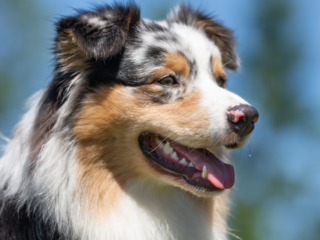It may be one of the most expressive parts of our dogs! Our Shih Tzus tail can say so much about our four-legged friends. Whether it’s ferociously wagging or tucked between their legs their tail has a story to tell us.
If you have wondered what your Shih Tzu is trying to communicate with you or how your dog’s tail compares to others, you have come to the right place. I’ve talked to owners and vets and done all the research for you.
A Shih Tzus tail is moderately long about 6-10 inches and is a continuation of their spine. The shape of the tail is a sickle shape that arches over their back and rests on their hocks. The hair is left long and feathery.
In this article, you will find information about some of the most pressing issues or questions you may have about your Shih Tzu tail, what they should look like what to do if you expect a problem, how to groom, and why some Shih Tzus are born with a stub tail or no tail at all.
What Does A Shih Tzu Tail Look Like
Typically a Shih Tzu tail will be somewhat long compared to its body. It will be thicker at the part where it begins to extend from its hindquarters and then slowly taper to a point. Their tail will most likely be in the shape of a sickle or have an extended arch that curves up and over their body and rests on their hindquarters.
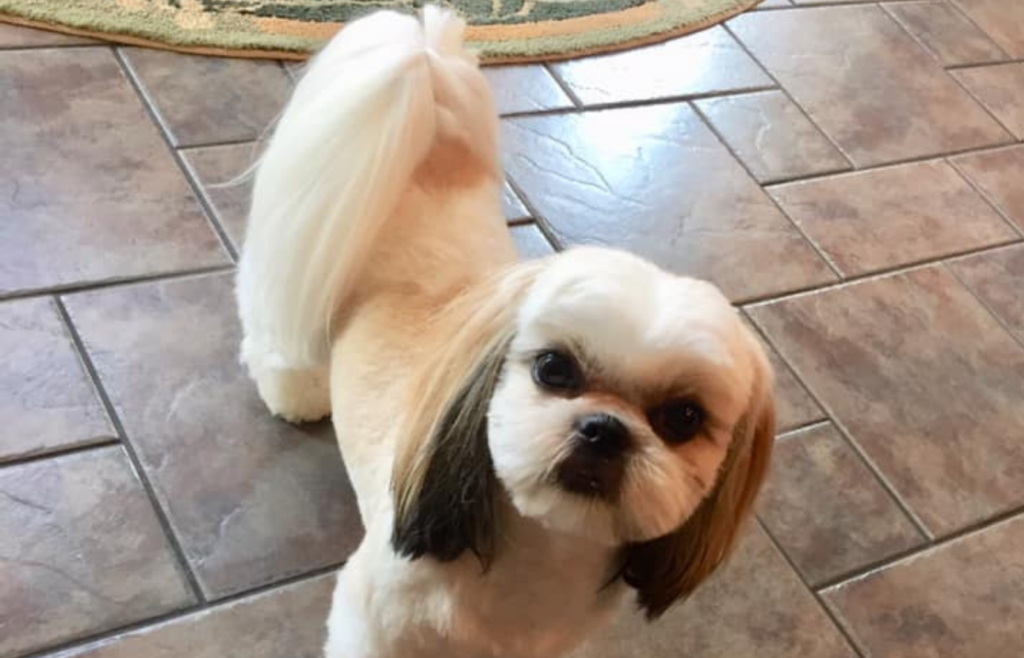
Do Shih Tzus get their tails docked?
Tail Docking or bobbing is the removal of portions of a dog’s tail. Historically tail docking was done to prevent injury for working dogs.
Shih Tzus are not a breed that traditionally gets their tails docked. A Shih Tzu’s tail is left to grow natural and long unless there is a medical reason to have it docked.
Some ShiPoos (Poodle Shihtzu mix) breeders will dock the puppies’ tails if they are following the AKC breed standard for the poodle. There is no reason they should get their tails docked and most owners prefer that they do not have docked tails.
ShiPoos are a mix between a Poodle and a Shih Tzu they are bred to be companion lap dogs. Traditionally the standard was to dock tails of working breed dogs to protect them from injuring their tails in the line of work.
Tails are such an important part of how these sweet little dogs communicate with us there is no reason they should ever get their tails docked.
Disclaimer: This post may contain affiliate links. We only recommend high-quality products that are used and recommended by real owners. If you use these links to buy something we earn a small commission.
Can Shih Tzus be born without a tail?
It is possible for Shih Tzus to be born without a tail. This would most likely be caused by any number of birth defects. If the puppy was part of a large litter it may have gotten kinked in utero or not formed properly.
Some dogs who are new mothers may accidentally chew off their puppy’s tail when cleaning and grooming them.
Some breeds mixed with Shih Tzu (like a Shipoo) may have docked tails which could be confused with being born without a tail.
If your Shih Tzu does not have a tail it most likely will not cause any lasting damage or problems.
If the tail is missing because of a genetic mutation (not the one discussed below) then they may be at a higher risk for malformation of their hindquarters. This will most likely be slight and shouldn’t cause any problems.
If you are worried about it, it is always a good idea to talk to your vet.
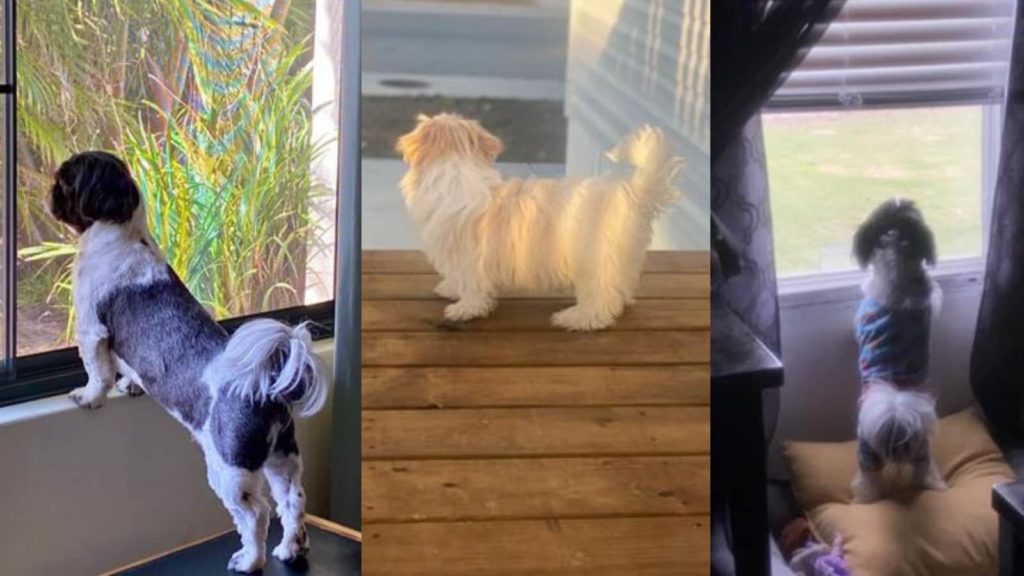
Do Shih Tzus have curled tails
Most Shih Tzus have a distinct arch to their tail, but do not have very curly tails. Some Shih Tzus may have a curly almost pig-like tail. A curly tail like this most likely means that the dog is not purebred, or they have a genetic deformity.
There are some Shih Tzu owners who have dogs with curly tails and they are purebred Shih Tzus.
Genetics of the mother and father play a big role in how your Shih Tzu’s tail will look.
There is a slightly higher chance that if your dog has a very curly tail that it could be mixed with another breed.
Some breeds that have curly tails that may be mixed with your Shih Tzu are a Pomeranian, a Pug, or a Chow Chow.
Some Shih Tzu owners have noticed that their dog’s tail curls more than normal and almost looks like a pig’s curly tail. If this is the case for your dog don’t panic, it shouldn’t cause any problems, but you may want to check with your vet at their next appointment to be sure.
As a Shih Tzu’s tail is an extension of their spine the posture of your Shih Tzu’s tail can give you some clues into your dog’s spine health.
If you notice that your dog is sitting with its back end slightly sideways and the tail looks to be off to one side it could mean that their spine is out of alignment and it would be best to get him an adjustment.
It would also be recommended that you don’t breed your Shih Tzu as this flaw can be passed down to the puppies and become more problematic for each generation going forward.
The one issue some owners have with their Shih Tzu curly tail is that it can make grooming more difficult. Having a curly tail can cause more matting at the base of the tail.
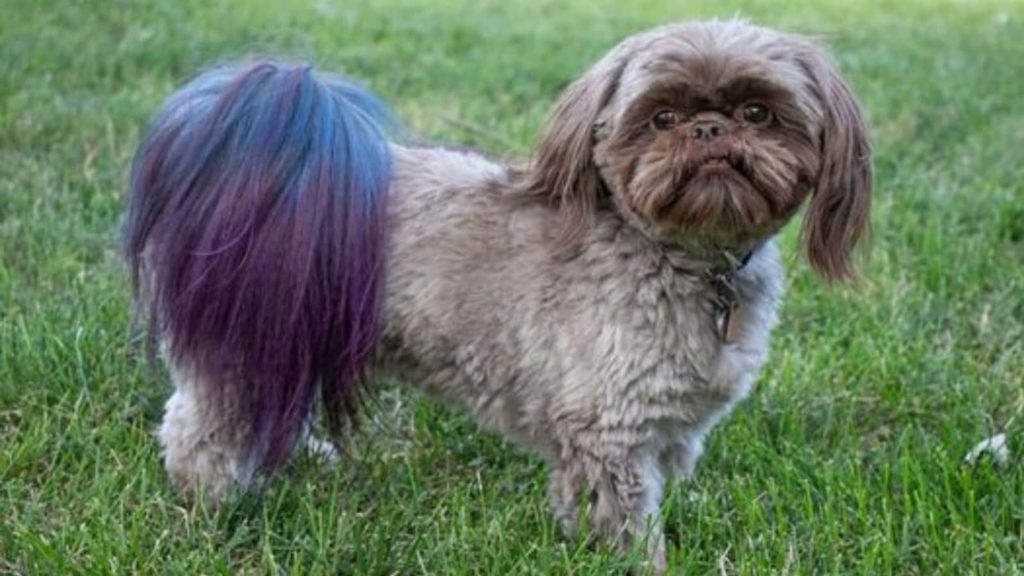
Shih Tzu Tail Wagging and Communication
Shih Tzus wag their tails for many different reasons. It’s a big part of how they communicate with you. Wagging their tail doesn’t always mean they are happy. They could be conveying other emotions like nervousness or fear as well.
The key to understanding their tail wags is to put it together with all the other contextual clues they are giving you. What are their ears doing, their eyes, how is their posture? Noticing these things as well will help you know why your Shih Tzu is wagging its tail.
For more fun articles about how your Shih Tzu communicates with you check out these links.
Why Does My Shih Tzu Stare at Me? (6 Reason Why?) – Paws and Learn
Do Shih Tzus Whine A lot? (quick solutions guide) – Paws and Learn
Here are some things your Shih Tzu could be communicating to you with its tail.
- Calm and chill – Tail in the natural resting position. Sleeping or resting or casually walking around.
- Greeting or I love you – Usually, a big carefree wag, accompanied by eye contact, coming to you and jumping on you or trying to get your attention.
- Curious or unsure – Backwards and gentle wagging. Maybe sniffing around a little, intense and curious staring. Looking to you for reassurance.
- I’m nervous or scared – The tail between their legs and possibly slightly moving. Body tense, eyes down, ears laid back. Could also be trying to communicate a submissive position.
- Aggression – Tail high in the air and rigid. Poised, rigid, and making eye contact. Could be barking or growling as well
. - Happy and Excited – Fast care-free wagging. Wiggling body, happy facial expressions. Body not tense, possibly going in circles around the object causing excitement such as a treat or toy.
A dogs tail is part of language , it tells joy , happiness, uncertainty, fear more happiness
Barbara G
There’s also been a study done that shows the direction that your dog wags their tail can show positive or negative emotion. Wagging their tail towards the right side of their body can indicate more positive emotions such as relaxed, and happy. Wagging their tails on the left side of their body is a sign of more negative emotions such as nervousness or fear.
For most Shih Tzus wagging their tails to communicate is a natural and normal thing for them to do.
Occasionally you will find a Shih Tzu that doesn’t wag its tail at all. Don’t worry, you are not alone. If your Shih Tzu doesn’t wag its tail it’s most likely just part of their personality or genes. It could also be that they have an extra curly tail that makes it more difficult for them to wag, but it could also indicate a medical problem and they should be seen by your vet to rule out any serious issues.
If your Shih Tzu has recently stopped wagging its tail then there could be other factors involved. If you have just moved, or they are new to your home this could just mean they are nervous and need some time to get acclimated to their new environment.
Some dogs are bigger tail-waggers than others. If your Shih Tzu doesn’t wag their tail at all then you will have to learn to identify other body language cues to help you understand what they are trying to tell you.
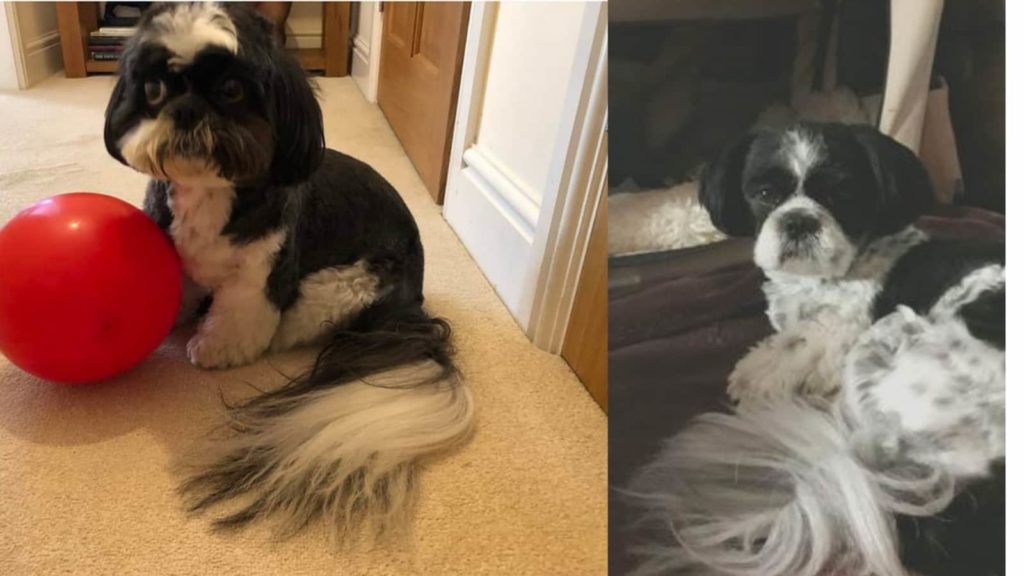
How to Groom Trim Shih Tzu Tails
Most of the time a Shih Tzu’s tail is left full and uncut. Part of their charm is the gorgeous plume flowing from their rear end. This does require daily or at the least bi-weekly brushing. This Brush works really well for keeping the mats out of their long feathery hair. If your Shih Tzu does get mats in their tail it may be necessary to trim the tail, or possibly thin it out a little bit.
There are a lot of fun and stylish cuts to choose from for your Shih Tzu’s tail grooming. Depending on how your Shih Tzu’s tail sits, how long it is and how much grooming you want to do on a weekly basis can help you determine which style or cut you would like. You may also want to think about the kinds of activities you do with your dog to help you decide which cut to do.
Flag Tail
How To Achieve the Look: This is a fun look that is named as such because it looks like the outline of a flag. The base of the tail and around the anus is cut short for the first 2-3 inches then the rest of the tail is trimmed into a rectangle shape.
Good For: Owners who like a nice neat look but still enjoy the beautiful natural look as well. This style needs to be brushed out at least once a week to keep mats from forming.
Plume Tail
How To Achieve the Look: This look is mostly left natural except that it is trimmed up a little around the anus and trimmed just enough to straighten up the edges, but not in a set rectangle shape like the flag style.
Good For: Owners that like a natural look but prefer to have it trimmed up just a bit to look more neat and tidy. This look needs to be brushed 2-3 times a week.
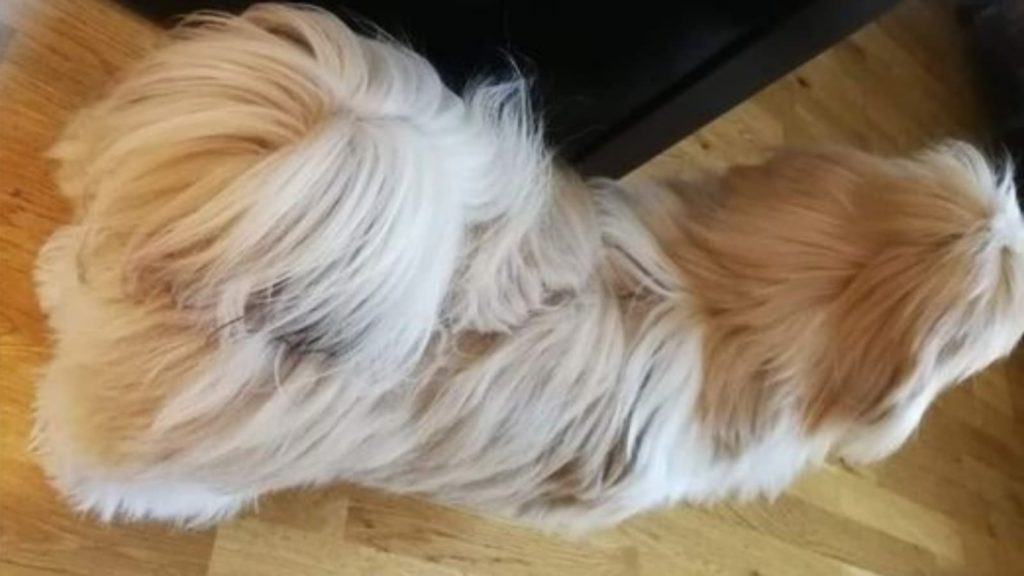
Long and Fluffy (all Natural)
How To Achieve the Look: Do nothing as far as trimming or cutting goes. This look is meant to be all-natural showcasing the original beauty of your gorgeous dog. You will need to spend some extra time brushing and keeping this tail mat and tangle-free.
Good For: Owners who love the all-natural look and long billowy tail of their Shih Tzu. It’s great for owners who don’t want to take their dogs to the groomers as often but requires at least 2-3 times a week of brushing if not daily in order to keep it free from mats and bugs.
Bottle Brush
How To Achieve the Look: Neat and trimmed short in the same style as the rest of the body the hair can be anywhere from 2-4 inches long and is the same length through the entire tail.
Good For: Owners who are very active and don’t want the hair to get caught or pulled on anything. Also good for owners who don’t want to spend as much time brushing the tail out multiple times a week. It will still require brushing about once a week but should be quick and easy.
Another option for dogs who tend to get mats in their tails or for owners that like a little less maintenance is to cut/style your Shih Tzu tail in what is called a bottle brush cut. It looks just like it sounds, the entire tail hair is trimmed to be only about 2-3 inches long and so it sticks out looking like a bottle brush.
Shih Tzu Tail Matted
If your dog’s tail has become too matted to get a brush through this video can help you fix that problem.
Shih Tzu Tail Problems and What to Do.
If your Shih Tzu is temporarily holding its tail in the down position it’s most likely an indication of submission or fear, but if your Shih Tzu is unable to hold its tail upright as it has in the past or seems to be in pain it could indicate one of the following; limber tail, Patellar Luxation, IVDD (Intervertebral disk disease), or swollen anal glands.
Here is a list of other things that Shih Tzu owners have said cause tail issues in their dogs. We will go into more details below.
- Swollen Anal Glands
- Bent or Broken Tail
- IVDD (Intervertebral disk disease)
- Patellar Luxation
- Tail Tip Necrosis
- Limber Tail (Swimmers Tail)
- Constipated
If your Shih Tzu is limping please read this article for more information on the causes. Why is My Shih Tzu Limping? – Paws and Learn
Swollen Anal Glands in a Shih Tzu
If you notice your Shih Tzu chasing its tail a lot more than usual, scooting its bum across the carpet, or biting/licking around the base of its tail it could be that its anal glands are blocked and swollen.
Sometimes the solution to your dog’s tail problem is as simple as getting your dog’s anal glands expressed. You can have your vet do it, or learn to do it yourself.
If you notice any blood, redness or swelling around the anus you need to take your dog to the vet ASAP! Excessive itching, scratching and swelling can cause trauma to the area or increase the chances of infection.
Bent or Broken Tail in Shih Tzu
Another reason your dog may have for holding its tail down, curled or tucked under between its legs is a bent or broken tail.
Signs of a broken or sprained tail
- Swelling
- Bend or kink in the tail
- Difficulty or pain moving the tail
- Wagging it to one side
- Holding it in an unusual position
If your dog seems to be in any pain or is licking or biting at its tail more than usual that can be an indication that something isn’t right.
Broken or strained tails are usually caused by a traumatic injury such as being stepped on or slammed in a door.
It can be extremely painful to your dog and needs to have immediate attention from a vet. Minor injuries will most likely heal with rest and immobility. More serious injuries may require surgery or amputation.
If your dog has always had a bend its tail and it doesn’t seem to be in any pain then this is probably an indication that at some point in its past it may have broken or strained its tail.
Unfortunately, A lot of owners who have adopted rescues have seen this in their sweet Shih Tzus.
IVDD in Shih Tzus
Another somewhat serious problem that can cause tail discomfort in Shih Tzu is a back issue known as IVDD. The technical term for this is Intervertebral disk disease (IVDD) it can also be described as a ruptured, slipped, bulging or herniated disk in your dog’s neck or back.
This type of back issue is fairly common in smaller dogs like Shih Tzu. Quite a few owners that I talked with have had this issue with their dogs. Some have been able to help their dog feel better with resting and medication, some have had to get their dogs operated on.
Here is a good resource to look at if you feel like this might be your Shih Tzu’s problem.
Shih Tzu Patellar Luxation
If your Shih Tzu is constantly Holding his tail down or it seems to be in a down position more often than the normal resting position this could indicate a problem called Luxating Patella.
This really is just a fancy way to stay a misplaced knee cap. Besides the tail, another indication this may be the problem is if you notice your dog stretching out their rear limbs and walking in circles, or possible yelping or whining in pain.
Luxated Patella is a common problem for small breeds and often will self-correct after a few days or rest and stretching.
If it seems to be causing your dog a lot of pain or the problem is not going away it’s best to take your dog to the vet. They will assess the situation and if this is a recurring problem for your dog may recommend surgery to fix the problem. If surgery is performed it should be a permanent fix for your dog.
Shih Tzu Tail Infection (Tail Tip Necrosis)
This is a very serious problem, but thankfully very rare in Shih Tzu. It can be important though that you learn to identify it right away so the issue can be dealt with before it causes permanent damage.
This can be caused by the constant beating of the tail against objects that may harbor bacteria. If the tail gets an open wound and the bacteria gets in it can lead to an infection that will spread and cause the tissue to become damaged or start dying.
Watch for hair loss or baldness at the end of the tail. Excessive itching, bloody or brittle skin, foul-smelling, excessive biting or the tail.
Take your dog to the vet right away if you notice any of these things in your dog. The vet will assess and most likely have to amputate the infected part of the tail. This may be a very sad thing to have to deal with, but if the infection spreads it could endanger your dog’s life.

What is Limber (Swimmers) Tail In Shih Tzu and What to Do
If you notice your Shih Tzu’s tail hanging down and it looks limp and unnatural then he may have a condition known as Limber Tail.
Limber tail Also known as swimmer’s tail, frozen tail, dead tail, broken wag, or cold tail is a condition that causes your dog to hold his tail limp and down instead of the usual upright position. Its official name is Acute Caudal Myopathy.
It is most likely to happen after your dog has had very active or strenuous play, exercise, or excessive tail wagging. Sometimes a lot of swimming can cause it, being in cold wet weather, if they are confined to their crate too long, or if your dog’s tail is wagging and getting whacked on various surfaces.
This could cause your dog pain and swelling in their tail, making it difficult to sit. Usually, this condition will go away on its own after a few days of rest. It’s important to try and limit exercise and movement if you notice that your dog is experiencing this problem. If it is causing your dog a lot of pain then consulting your vet is a good idea.
Usually, this isn’t a chronic problem, but it is a good idea to figure out what may have triggered it in the first place and try to avoid that activity if possible. Coldwater play, or being confined in a crate too long are often things that could trigger this condition.
Lump or Cyst on Shih Tzu Tail
Finding a lump on your Shih Tzus tail can be very concerning. While it’s not very common, a lump on your dog’s tail can happen. These masses can be cysts, warts, infected sebaceous glands, or benign tumors. It is also possible that it is a malignant tumor. Your vet will need to remove it and do tests on it.
It’s important to have any lumps removed from your dog’s tail in order to keep them from growing larger as well as prevent them from bleeding. Wagging a tail that is bleeding becomes a big mess quite quickly.
Shih Tzu Chasing its Tail or Chewing and Biting its Tail
For the most part, if your Shih Tzu is chasing its tail it’s most likely just a harmless and adorable game. Puppies tend to do this a lot because they are so playful and exploring more about their world and discovering their fun long tails. If your dog is chasing his tail it might be because he’s bored or it’s just a fun game for him.
The problem comes when your dog is obsessively chasing its tail and it seems like they are in pain stressed or biting its tail and causing things like bleeding, or hair loss.
If this is the case then rightfully you are probably concerned.
The cause for this could be one of several things. Here are the things that you can look for.
- Impacted anal glands
- Parasites like fleas or ticks in the tail
- Injury or sharp pain somewhere on the tail
- Allergies or itchy skin
How to Keep Poop From Sticking to your Shih Tzu’s Tail and Butt
This can be a common smelly problem for long hair dogs. If it happens often and doesn’t get taken care of it can also lead to serious health issues as well.
Here are some tips to keep your fur baby’s fluffy rear end clean.
- Keep the hair near their rear clean and trimmed.
- Keep wipes handy to clean it out right away.
- Add more fiber to your dogs diet.
- Check for infections or parasites such as worms
Other Articles All About Your Shih Tzu
Why Does My Shih Tzu Eat Everything? (Grass, Poop, Sticks, Dirt)



